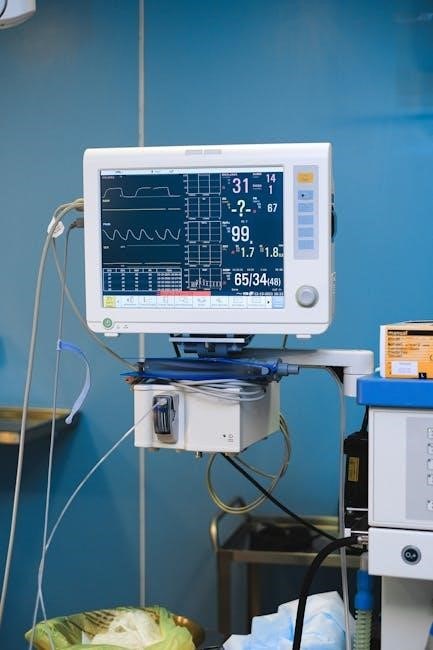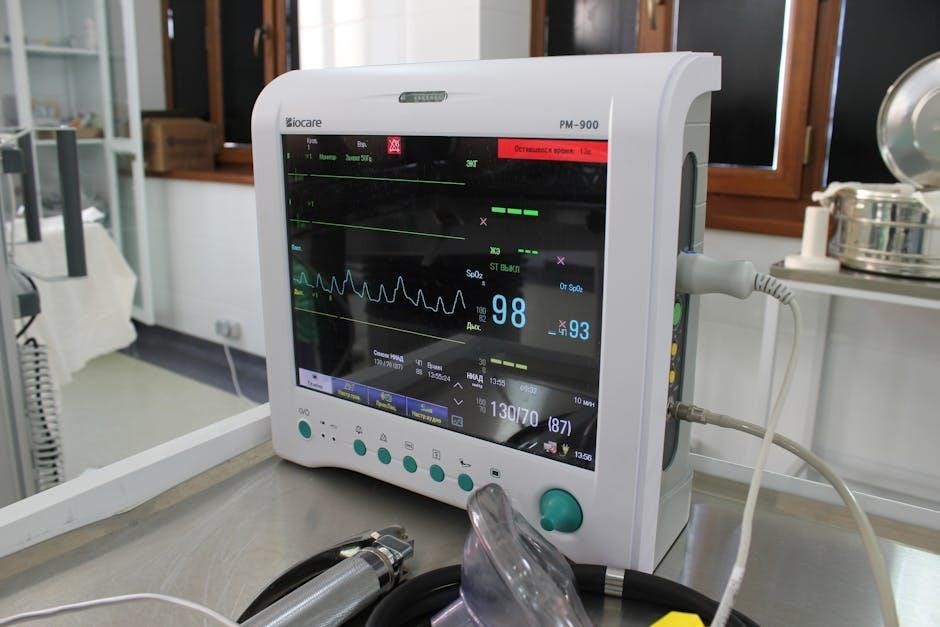icu basics for nurses pdf
This section provides a foundational overview of ICU nursing, covering essential concepts, roles, and skills required for delivering high-quality critical care․ It serves as a starting point for nurses new to the ICU environment, offering insights into patient assessment, monitoring, and therapeutic interventions․ The guide emphasizes the importance of understanding basic physiology, equipment operation, and interdisciplinary collaboration to ensure optimal patient outcomes․ It also highlights resources for continued learning and professional development in critical care nursing․
Overview of the Intensive Care Unit (ICU)
The Intensive Care Unit (ICU) is a specialized department in hospitals designed to provide highly skilled, intensive care to critically ill or injured patients․ The ICU is equipped with advanced medical technologies and staffed by multidisciplinary teams to manage life-threatening conditions․ Patients in the ICU require close monitoring, complex therapies, and continuous interventions to stabilize their health․ The unit operates 24/7, addressing a wide range of acute conditions, from cardiovascular instability to respiratory failure․ Nurses and healthcare providers in the ICU work collaboratively to deliver individualized care, ensuring optimal patient outcomes․ The ICU environment is fast-paced and demanding, requiring a strong foundation in critical care principles and practices․ This section provides an overview of the ICU structure, patient population, and the essential care delivered within this setting․
The Role of the ICU Nurse
The ICU nurse plays a vital role in delivering specialized care to critically ill patients․ They are responsible for continuous monitoring, administering medications, and operating advanced medical equipment․ ICU nurses assess patients’ conditions, identify changes, and implement interventions to stabilize their health․ They work collaboratively with physicians and other healthcare professionals to develop and execute individualized care plans․ Additionally, ICU nurses provide emotional support to patients and their families during stressful times․ Their expertise in critical care ensures that patients receive timely and appropriate interventions, making them indispensable in the ICU setting․ The role requires strong clinical skills, attention to detail, and the ability to work effectively in high-pressure situations․
Essential Skills for ICU Nurses
ICU nurses must possess a combination of clinical expertise, critical thinking, and emotional resilience․ Proficiency in hemodynamic monitoring, ventilator management, and medication administration is crucial․ Strong assessment skills enable nurses to identify subtle changes in patient conditions․ Effective communication is vital for collaborating with interdisciplinary teams and relaying patient status to families․ Time management and prioritization are essential in a fast-paced environment․ Compassion and empathy are critical for supporting patients and families during stressful times․ Continuous learning and adaptability are necessary to stay updated with evidence-based practices․ These skills ensure that ICU nurses can provide high-quality, patient-centered care in complex and dynamic situations, ultimately improving patient outcomes and supporting their colleagues in delivering exceptional care․

Understanding the ICU Environment

The ICU environment is a fast-paced, high-acuity setting requiring precise care for critically ill patients․ It involves advanced technology, continuous monitoring, and collaboration among healthcare professionals to ensure optimal patient outcomes․
Common Equipment in the ICU
In the ICU, nurses work with advanced medical equipment to monitor and support critically ill patients․ Ventilators are essential for patients requiring respiratory support, delivering oxygen and maintaining breathing patterns․ ECG monitors continuously track heart activity, while infusion pumps manage precise medication administration․ Dialysis machines are used for patients with renal failure, and point-of-care ultrasound devices aid in quick assessments; Central venous catheters (CVCs) and arterial lines enable blood sampling and hemodynamic monitoring․ Additionally, crash carts, defibrillators, and feeding pumps are critical for emergencies and nutritional support․ Understanding this equipment is vital for providing safe and effective care in the ICU environment․
Basic Physiology and Patient Assessments

Understanding basic physiology is crucial for ICU nurses to assess and manage critically ill patients effectively․ Key areas include respiratory, cardiovascular, and neurological systems․ Nurses must evaluate airway patency, breathing patterns, and oxygenation, as well as cardiovascular stability through heart rate, blood pressure, and hemodynamic parameters; Neurological assessments focus on level of consciousness, pupillary responses, and motor function․ Regular monitoring of vital signs, laboratory results, and imaging studies helps identify trends and potential complications․ This foundational knowledge enables nurses to prioritize interventions, optimize patient outcomes, and provide evidence-based care tailored to individual needs in the dynamic ICU environment․
ICU Patient Monitoring Systems
ICU patient monitoring systems are essential for continuously assessing the physiological status of critically ill patients․ These systems include electrocardiogram (ECG) for heart activity, pulse oximetry (SpO2) for oxygen saturation, and invasive blood pressure monitoring․ Respiratory monitoring involves capnography and ventilator settings to ensure adequate ventilation․ Additionally, neurological monitoring may include intracranial pressure (ICP) and cerebral oxygenation sensors․ These tools provide real-time data, enabling nurses to promptly identify changes in patient condition and intervene effectively․ Monitoring systems are integrated into patient care plans to optimize outcomes, reduce complications, and ensure timely adjustments to therapies in the dynamic ICU environment․

Key Concepts in Critical Care Nursing
Essential principles include hemodynamic monitoring, ventilator management, and neurological assessments․ These concepts ensure comprehensive care for critically ill patients, focusing on stability, comfort, and recovery․
Cardiovascular Monitoring and Hemodynamic Support
Cardiovascular monitoring in the ICU involves tracking vital signs such as blood pressure, heart rate, and cardiac output․ Hemodynamic support includes managing vasoactive medications and fluid therapy to maintain adequate perfusion․ Nurses use tools like arterial lines and Swan-Ganz catheters to assess cardiac function and guide interventions․ Understanding these principles is crucial for stabilizing critically ill patients and preventing complications․ Proper interpretation of hemodynamic data ensures timely adjustments to treatment, optimizing patient outcomes․ This section provides a detailed overview of cardiovascular monitoring techniques and the role of hemodynamic support in critical care nursing․
Respiratory Care and Ventilator Management
Respiratory care in the ICU focuses on managing patients with acute respiratory failure, often requiring mechanical ventilation․ Nurses must assess lung function, oxygenation, and ventilation to optimize patient outcomes․ Ventilator management involves selecting appropriate modes (e․g․, SIMV, APRV) and settings (tidal volume, PEEP) based on patient needs․ Monitoring arterial blood gases and respiratory mechanics helps guide adjustments․ Key interventions include ensuring patient-ventilator synchrony, preventing ventilator-induced lung injury, and promoting lung recruitment․ Weaning from mechanical ventilation is a critical process requiring careful assessment of readiness and gradual reduction of support․ Effective respiratory care improves patient comfort, reduces complications, and facilitates recovery in critically ill patients․
Neurological Monitoring and Patient Comfort
Neurological monitoring in the ICU involves assessing patients’ mental status, motor function, and cranial nerve responses to identify potential complications․ Tools like the Glasgow Coma Scale (GCS) are used to evaluate consciousness levels; Nurses monitor for signs of neurological deterioration, such as pupillary changes or decreased responsiveness, and intervene promptly․ Pain assessment and management are critical, as uncontrolled pain can worsen neurological outcomes․ Sedation is carefully titrated to ensure patient comfort without impairing neurological evaluation․ Additionally, strategies to prevent delirium, such as promoting sleep-wake cycles and minimizing noise, are essential․ Ensuring patient comfort and dignity while maintaining neurological stability is a priority in ICU care․

Medications and Therapies in the ICU
ICU medications and therapies focus on stabilizing critically ill patients, managing pain, and supporting organ function․ Common drugs include sedatives, analgesics, vasopressors, and antibiotics; Nurses must administer these precisely, monitoring for adverse effects and adjusting dosages as needed to ensure patient safety and optimal outcomes․
Common Medications Used in Critical Care
In the ICU, medications are tailored to address life-threatening conditions and support organ function․ Vasopressors, such as norepinephrine, are used to maintain blood pressure, while sedatives like propofol and fentanyl manage pain and agitation․ Analgesics, including morphine, are essential for pain relief․ Broad-spectrum antibiotics, like ceftriaxone, are administered to treat or prevent infections․ Additionally, medications like heparin and insulin are used to manage coagulation and glucose levels, respectively․ Nurses must carefully monitor these medications, adjusting dosages as needed to ensure efficacy and minimize adverse effects․ Understanding these drugs is crucial for providing safe and effective care in the critical care setting;
Pain Management and Sedation in the ICU
Pain management and sedation are critical in the ICU to ensure patient comfort, reduce anxiety, and facilitate life-saving interventions․ Common analgesics like fentanyl and morphine are used to alleviate pain, while sedatives such as propofol and midazolam help patients tolerate mechanical ventilation and invasive procedures․ The goal is to maintain a balance between adequate sedation and the ability to assess neurological function․ Nurses monitor sedation levels using tools like the Richmond Agitation-Sedation Scale (RASS) and adjust medications accordingly․ Regular assessment of pain and sedation is essential to avoid over-sedation, which can prolong ventilation and hospital stays․ Effective pain and sedation strategies improve patient outcomes and reduce long-term psychological distress․
Nutritional Support for ICU Patients
Nutritional support is vital for ICU patients to maintain strength, prevent malnutrition, and promote recovery․ Early enteral nutrition is often recommended to preserve gut function and reduce complications․ Parenteral nutrition may be used when enteral feeding is not feasible․ Nurses play a key role in assessing patients’ nutritional needs, monitoring intake, and ensuring proper delivery of nutrients․ Regular assessment of caloric requirements and glucose levels is essential to avoid overfeeding or underfeeding․ Adequate nutritional support helps improve patient outcomes, reduce hospital stays, and enhance wound healing․ ICU nurses must adhere to evidence-based guidelines to optimize nutritional care and minimize risks associated with malnutrition in critically ill patients․

Communication and Collaboration in the ICU
Effective communication and teamwork are crucial in the ICU, ensuring seamless coordination of patient care among nurses, doctors, and other healthcare professionals to improve patient outcomes and safety․
SBAR Reporting and Effective Communication
SBAR (Situation, Background, Assessment, Recommendation) is a standardized communication tool used in the ICU to ensure clear and effective handoffs․ It helps nurses and healthcare providers share patient information succinctly, reducing errors and improving patient safety․ The Situation provides context, Background includes relevant patient history, Assessment offers clinical evaluation, and Recommendation outlines the proposed plan․ Effective communication in the ICU is critical for coordinating care, addressing urgent needs, and fostering collaboration among team members․ By using SBAR, nurses can communicate efficiently, ensuring that all stakeholders are aligned and patient care remains seamless․ This structured approach enhances teamwork and decision-making in high-stakes environments․
Interdisciplinary Collaboration in Critical Care
Interdisciplinary collaboration is essential in the ICU, where patients require complex, coordinated care․ Nurses, physicians, respiratory therapists, and other specialists must work together to deliver comprehensive care․ Effective teamwork ensures that all aspects of patient needs are addressed, from physiological support to emotional comfort․ Clear communication and mutual respect among team members foster a collaborative environment, enhancing patient outcomes․ Each professional brings unique expertise, and their collective efforts ensure that care is tailored to the patient’s specific condition․ Strong interdisciplinary collaboration reduces errors, improves decision-making, and supports a patient-centered approach, ultimately benefiting both patients and their families․ It is a cornerstone of high-quality critical care․
Documentation and Handover Practices
Accurate and timely documentation is critical in the ICU to ensure continuity of care and patient safety․ Nurses must record vital signs, medications, interventions, and patient responses thoroughly․ Handover practices, such as using SBAR (Situation, Background, Assessment, Recommendation), ensure seamless communication between shifts and teams․ Standardized documentation tools help maintain consistency and reduce errors․ Clear and concise handovers prevent miscommunication and ensure that all team members are informed about the patient’s condition and care plan․ Effective documentation also serves as a legal record of care provided․ Regular audits and training can improve documentation practices, enhancing patient outcomes and accountability in the ICU setting․

Ethical Considerations in ICU Nursing
Ethical considerations in ICU nursing involve respecting patient autonomy, ensuring beneficence, and managing end-of-life care with compassion․ Nurses must navigate complex decisions, balancing patient rights and medical ethics while addressing the emotional and psychological challenges of critical care․
End-of-Life Care and Ethical Decision-Making
End-of-life care in the ICU involves complex ethical decisions, requiring nurses to balance patient autonomy, beneficence, and justice․ Pain management, withdrawal of life support, and palliative care are critical aspects․ Nurses must communicate empathetically with families, ensuring patients’ wishes are respected․ Ethical dilemmas often arise, necessitating collaboration with the healthcare team to align care with patient values․ Maintaining dignity and comfort during the dying process is paramount․ Nurses play a vital role in advocating for patients and supporting families through grief, ensuring ethical practices guide all decisions․ This requires strong moral reasoning and adherence to professional guidelines․

Patient Rights and Family Support in the ICU
Respecting patient rights is paramount in the ICU, ensuring dignity, privacy, and informed consent․ Nurses must advocate for patients’ autonomy, even when they cannot communicate․ Families require emotional support and clear communication about their loved one’s condition and prognosis․ Involving families in care decisions fosters trust and collaboration․ Providing access to spiritual or cultural support is essential․ Nurses should also ensure families understand visitation policies and are updated regularly․ Balancing patient confidentiality with family needs is critical․ Supporting families during stressful times enhances their experience and contributes to holistic patient care, emphasizing empathy and compassion in all interactions․ This approach upholds ethical standards and patient-centered care․
Managing Stress and Burnout in ICU Nurses
Working in the ICU can lead to high levels of stress and burnout due to the intense emotional and physical demands of critical care․ Nurses must prioritize self-care to maintain their well-being․ Strategies include mindfulness practices, regular exercise, and seeking support from colleagues or mental health professionals․ Employers should promote a supportive work environment by managing workload, encouraging open communication, and providing access to mental health resources․ Recognizing signs of burnout, such as emotional exhaustion or compassion fatigue, is crucial for early intervention․ Fostering resilience and a culture of support within the ICU team can help mitigate these challenges and sustain long-term well-being․

Resources for Continued Learning
Recommended textbooks like ICU Basics for Nurses by Kathleen Perrin and Carrie MacLeod offer comprehensive insights․ Online courses and professional organizations like AACN provide updates and networking opportunities․
Recommended Textbooks and Guidelines for ICU Nurses
Essential textbooks such as ICU Basics for Nurses by Kathleen Perrin and Carrie Ed MacLeod provide comprehensive insights into critical care nursing․ Published in 2017, this guide is tailored for baccalaureate-level courses and hospital orientation programs․ Another key resource is The ICU Book by Arora and Laha, which offers a detailed overview of intensive care medicine․ Professional organizations like the American Association of Critical Care Nurses (AACN) publish evidence-based guidelines and practice standards․ Additionally, online repositories and medical journals, such as Australian Critical Care, offer updated protocols and research findings․ These resources are invaluable for both novice and experienced ICU nurses seeking to enhance their knowledge and skills․
Online Courses and Training Programs
Online courses and training programs are invaluable for ICU nurses seeking to enhance their skills and knowledge․ Platforms like the American Association of Critical Care Nurses (AACN) offer specialized training modules on critical care topics․ These programs cover essential areas such as hemodynamic monitoring, ventilator management, and pain assessment․ Many courses are designed for flexibility, allowing nurses to learn at their own pace․ Additionally, resources like the Residents Critical Care Handbook provide practical guidance for managing critically ill patients; These online tools help nurses stay updated on evidence-based practices and improve their ability to deliver high-quality patient care in the ICU environment․
Professional Organizations and Networking Opportunities
Professional organizations provide ICU nurses with invaluable networking opportunities and resources for career growth․ The American Association of Critical Care Nurses (AACN) and the Society of Critical Care Medicine (SCCM) are prominent groups offering memberships, conferences, and educational materials․ These organizations facilitate collaboration among healthcare professionals, fostering the exchange of best practices and innovative care strategies․ Networking within these groups enables nurses to stay updated on critical care advancements and connect with colleagues worldwide․ Additionally, they provide access to exclusive training programs, certifications, and research updates, helping nurses enhance their expertise and contribute to the evolution of ICU care․